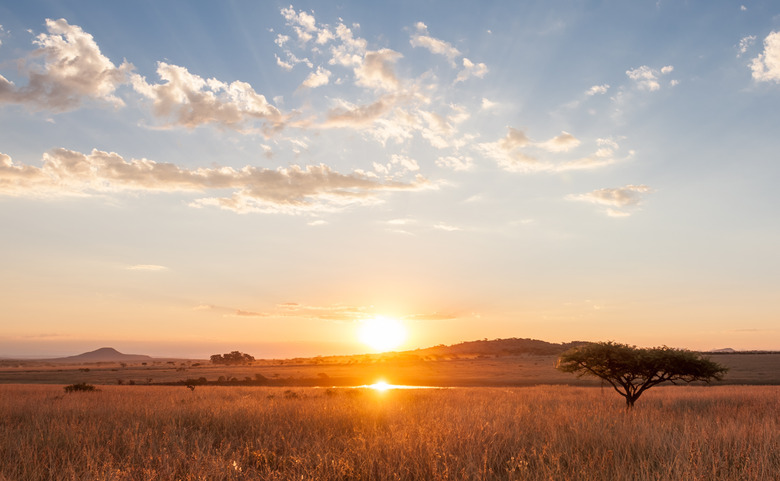The Difference Between A Grassland And Savanna
Grasslands and the open parklands and woodlands known as savannas cover large expanses of the Earth's surface, from the torrid tropics to boreal latitudes. Distinguishing between grassland and savanna can be a bit complicated because of confusing, overlapping terminology, and the fact that the two biomes share many ecological characteristics. At the most basic level, the difference between the two has to do with the relative proportion of grasses and woody plants.
TL;DR (Too Long; Didn't Read)
Grasslands and savannas are related and often intermixed biomes typically dominated by grasses. True grassland supports few if any woody plants, while savannas include varying proportions of shrubs and trees, grading into woodland where canopies begin mingling.
Introducing the Grassland
Introducing the Grassland
A "grassland" comes by its name honestly: It's an ecosystem dominated by grasses, although non-woody plants such as sedges and a wide variety of forbs may be major components as well. There are many synonyms used for this biome: "steppe," for instance – although woody plants prevail in shrub-steppe communities – and "prairie," a French-derived term primarily used in North America. Different grassland biomes cover the most acreage in the tropics and subtropics as well as temperate regions under the influence of midlatitude-steppe climates. Where trees or shrubs exist in a true grassland, they tend to be highly localized along rivers or streams, for example, or on isolated outcrops or moist hillsides.
Introducing the Savanna
Introducing the Savanna
The most widely accepted modern use of the term "savanna" refers to grassy ecosystems with a significant component of woody-plant cover, either shrubs or trees. Ecologists may refer to "shrub savannas" or "bush savannas" vs. "tree savannas." These may grow widely scattered or quite closely spaced, but if tree canopies overlap the "savanna" it is a woodland. Although people commonly think of savannas in their tropical or subtropical form – those of sub-Saharan Africa, for example, or of portions of the South American llanos – these communities also exist in a wide variety of ecological settings in temperate zones. Pine or oak savannas, for example, form the transition between forest and grassland in parts of North America or flourish in countrysides regularly impacted by wildfire.
The Grassland and Savanna Interplay
The Grassland and Savanna
Interplay
From the tropics to the midlatitudes, grasslands and savannas often prevail where rainfall is limited or highly seasonal, precluding the growth of closed-canopy forest. With their shallow, dense root networks, grasses can efficiently process water during the wet season and then endure protracted dry seasons by maintaining only their below ground structures and a growing tip. Woody shrubs and trees survive drought conditions by reaching deep water, even just small amounts, with long taproots. Where rainfall is very scarce, grasses may use up too much of the available water for woody plants to survive the dry season, resulting in a pure semiarid grassland. Annual rainfall of perhaps a foot might be enough to allow shrubs a foothold to create a bush savanna. Slightly more precipitation could foster the growth of scattered trees.
Rainfall, however, is not the only factor determining the development and persistence of grassland or savanna. Fire, heavy grazing, or regular flooding, for example, may maintain grasslands or open savannas by prohibiting dense woody growth, and soil type can play an important role, too, by determining water and nutrient availability. It's not always a simple equation. Where free-ranging livestock preferentially eat grasses, for example, overgrazed grassland may transform into shrubland as less palatable woody brush spreads.
Clearing Up Terms
Clearing Up Terms
Terminology can muddy the waters about these sunny, airy and pretty much universally grassy landscapes. Some ecologists, for example, describe a basically treeless tropical grassland as "tropical savanna," perhaps distinguishing it from bush or tree savanna by calling it "grass savanna." In the tropics and subtropics, shrub or bush savanna may be called "bushland" or simply "bush." "Bush," though, is also widely used colloquially to be mean "backcountry" or "wilderness," not specifically to one or another ecosystem.
The term "parkland" or "park savanna" may generally describe savannas of very large, wide-crowned trees: an old-growth parkland of ponderosa pines in the American West, for example, or a baobab parkland in Africa or Australia. In a different sense, parkland may refer to landscapes of island-like tree groves amid grassland: the "aspen parkland" of the prairie-forest threshold in central Canada and the adjacent northern U.S., say, or the so-called "termite savannas" of parts of Africa, where trees grow on old termite mounds elevated above seasonally flooded grasslands.
It's common shorthand, meanwhile, to call grasslands "plains," but strictly speaking "plain" is a topographic label, referring to relatively level terrain, rather than an ecological one. From the Serengeti to the North American Great Plains, such flatlands often correspond with grassy steppes, but you can also have a thickly forested plain.
References
- University of California Museum of Paleontology: The Grassland Biome
- Radford University: Temperate Grasslands
- Vegetation of the Earth (Heinrich Walter)
- Ecology of Tropical Savannas (B.J. Huntley, B.H. Walter, eds.)
- Minnesota Department of Natural Resources: Tallgrass Aspen Parkland
- Radford University (S.L. Woodward): Biomes of the World — Tropical Savannas
Cite This Article
MLA
Shaw, Ethan. "The Difference Between A Grassland And Savanna" sciencing.com, https://www.sciencing.com/difference-between-grassland-savanna-8427391/. 16 April 2018.
APA
Shaw, Ethan. (2018, April 16). The Difference Between A Grassland And Savanna. sciencing.com. Retrieved from https://www.sciencing.com/difference-between-grassland-savanna-8427391/
Chicago
Shaw, Ethan. The Difference Between A Grassland And Savanna last modified March 24, 2022. https://www.sciencing.com/difference-between-grassland-savanna-8427391/
